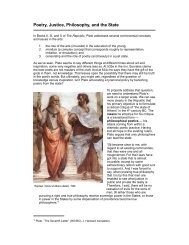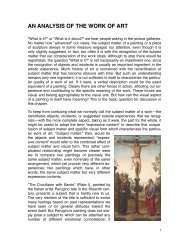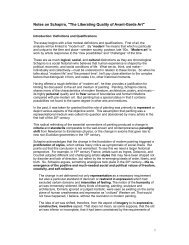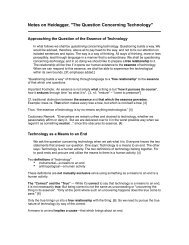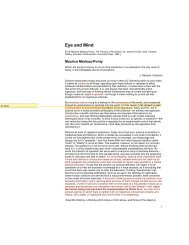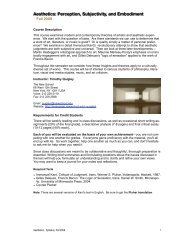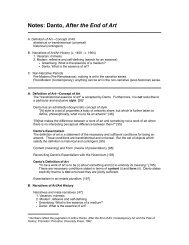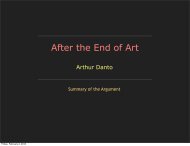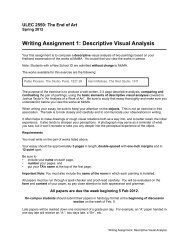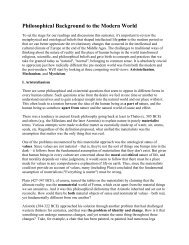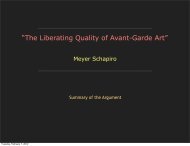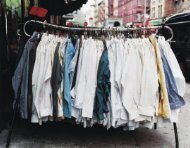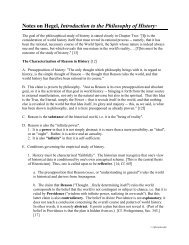The Art of Romare Bearden - Timothy R. Quigley
The Art of Romare Bearden - Timothy R. Quigley
The Art of Romare Bearden - Timothy R. Quigley
You also want an ePaper? Increase the reach of your titles
YUMPU automatically turns print PDFs into web optimized ePapers that Google loves.
<strong>The</strong> <strong>Art</strong> <strong>of</strong> <strong>Romare</strong> <strong>Bearden</strong>women who people the blues. And here, too, are renderings <strong>of</strong> thoserituals <strong>of</strong> rebirth and dying, <strong>of</strong> baptism and sorcery which giveceremonial continuity to the Negro American community.By imposing his vision upon scenes familiar to us all <strong>Bearden</strong>reveals much <strong>of</strong> the universally human which they conceal. Throughhis creative assemblage he makes complex comments upon history,upon society and upon the nature <strong>of</strong> art. Indeed, his Harlem becomesa place inhabited by people who have in fact been resurrected, recreated by art, a place composed <strong>of</strong> visual puns and artistic allusionsand where the sacred and pr<strong>of</strong>ane, reality and dream are ambiguously mingled. And resurrected with them in the guise <strong>of</strong> fragmentedancestral figures and forgotten gods (really masks <strong>of</strong> the instincts,hopes, emotions, aspirations and dreams) are those powers that nowsurge in our land with a potentially destructive force which springsfrom the very fact <strong>of</strong> their having for so long gone unrecognized,unseen.<strong>Bearden</strong> doesn't impose these powers upon us by explicit comment, but his ability to make the unseen manifest allows us someinsight into the forces which now clash and rage as Negro Americansseek self-definition in the slums <strong>of</strong> our cities. <strong>The</strong>re is a beauty here,a harsh beauty which asserts itself out <strong>of</strong> the horrible fragmentationwhich <strong>Bearden</strong>'s subjects and their environment have undergone.But, as I have said, there is no preaching; these forces have beenbrought to eye by formal art. <strong>The</strong>se works take us from Harlemthrough the south <strong>of</strong> tenant farms and northward-bound trains totribal Africa; our mode <strong>of</strong> conveyance consists <strong>of</strong> every device whichhas claimed <strong>Bearden</strong>'s artistic attention, from the oversimplifiedand scanty images <strong>of</strong> Negroes that appear in our ads and photojournalism, to the discoveries <strong>of</strong> the School <strong>of</strong> Paris and the Bauhaus.He has used the discoveries <strong>of</strong> Giotto and Pieter de Hooch no lessthan those <strong>of</strong> Juan Gris, Picasso, Schwitters and Mondrian (whowas no less fascinated by the visual possibilities <strong>of</strong> jazz than by thecompositional rhythms <strong>of</strong> the early Dutch masters), and has discovered his own uses for the metaphysical richness <strong>of</strong> African sculptural forms. In brief, <strong>Bearden</strong> has used (and most playfully) all <strong>of</strong> hisartistic knowledge and skill to create a curve <strong>of</strong> plastic vision whichreveals to us something <strong>of</strong> the mysterious complexity <strong>of</strong> those whodwell in our urban slums. But his is the eye <strong>of</strong> a painter, not that <strong>of</strong>a sociologist and here the elegant architectural details which existin a setting <strong>of</strong> gracious but neglected streets and the buildings inwhich the hopeful and the hopeless live cheek by jowl, where failedhuman wrecks and the confidently expectant explorers <strong>of</strong> thefrontiers <strong>of</strong> human possibility are crowded together as incongru679



